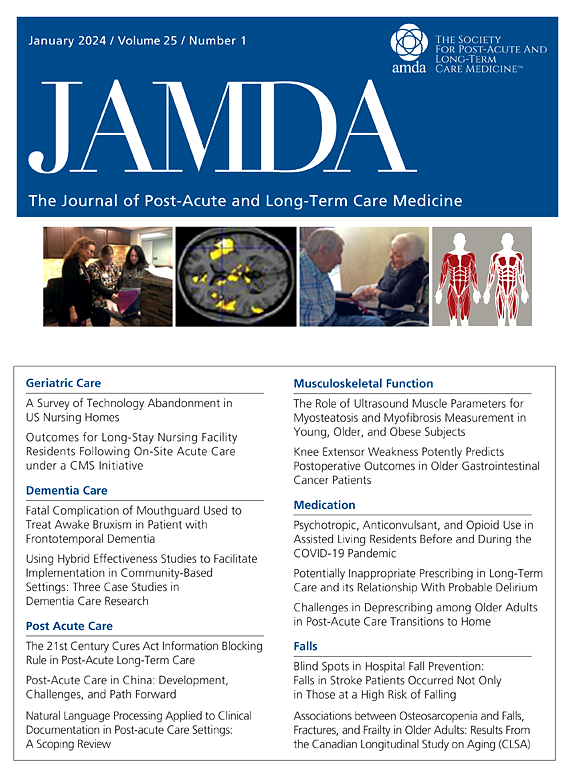Transforming Transitional Care: Early Hospital Discharge through the Care at Home Program
IF 4.2
2区 医学
Q2 GERIATRICS & GERONTOLOGY
Journal of the American Medical Directors Association
Pub Date : 2025-06-05
DOI:10.1016/j.jamda.2025.105681
引用次数: 0
Abstract
Objectives
Every year, thousands of patients face the challenging transition from hospital to home, resulting in high readmission rates and excessive resource use. Our telemedicine-based Care at Home (CaH) program, which facilitates early discharge, was assessed for its impact on 30-day readmissions, length of hospital stay (LoS), and total charges.
Design
Retrospective cohort study comparing standard inpatient care with the CaH program, which features telemedicine support and continuous monitoring provided by nurses, paramedics, and physicians after early hospital discharge. This program prioritizes patients at higher risk for readmission.
Setting and Participants
Data were derived from 2866 hospital admissions covering select diagnostic-related groups (DRGs) between January and December 2023. Of these, 215 patients were enrolled in CaH and 2651 received standard inpatient care.
Methods
We analyzed 30-day readmission rates, LoS, and total charges. Categorical variables were evaluated using χ2 tests, and the Mann-Whitney U (MWU) test was applied for skewed continuous variables. A Cox proportional hazards model assessed time to readmission, using a 1.15 noninferiority margin.
Results
The 30-day readmission rate was 11.2% in the CaH group and 12.8% in the control group (P = .57). Hazard ratios (HRs) favored CaH but exceeded the 1.15 noninferiority margin (adjusted HR, 0.82; 95% CI, 0.54–1.24; P = .35). CaH did achieve significantly lower LoS (mean 4.7 vs 7.7 days; MWU P < .001) and total charges (mean $54,491 vs $84,245; MWU P < .001). DRG-specific analyses revealed variable readmission outcomes but consistent reductions in LoS and costs across most DRGs for patients in CAH.
Conclusions and Implications
CaH yielded comparable 30-day readmission rates while significantly lowering LoS and total costs, although it did not achieve the predefined noninferiority margin. Potential selection bias and differences in patient acuity may have influenced these findings. Further research should focus on refining patient selection, developing condition-specific protocols, and examining broader applications of telemedicine-driven early discharge models.
转变过渡性护理:通过居家护理计划早日出院。
目的:每年,成千上万的患者面临着从医院到家庭的挑战性转变,导致高再入院率和过度的资源使用。我们以远程医疗为基础的家庭护理(CaH)项目促进了早期出院,评估了其对30天再入院、住院时间(LoS)和总费用的影响。设计:回顾性队列研究,比较标准住院治疗与CaH方案,其特点是远程医疗支持和护士、护理人员和医生在早期出院后提供的持续监测。该项目优先考虑再入院风险较高的患者。环境和参与者:数据来自2023年1月至12月期间选定的诊断相关组(drg)的2866例住院病例。其中,215名患者入组CaH, 2651名患者接受标准住院治疗。方法:我们分析30天再入院率、LoS和总费用。分类变量采用χ2检验,偏态连续变量采用Mann-Whitney U检验。Cox比例风险模型评估再入院时间,使用1.15的非劣效性余量。结果:CaH组30天再入院率为11.2%,对照组为12.8% (P = 0.57)。风险比(HR)倾向于CaH,但未达到1.15的非劣效性阈值(调整后的HR为0.82;95% ci, 0.54-1.24;P = .35)。CaH的LoS(4.7天vs 7.7天,P < 0.001)和总收费(平均54,491美元vs 84,245美元,P < 0.001)显著降低。drg特异性分析揭示了不同的再入院结果,而在CaH患者的大多数drg中,LoS和成本的降低是一致的。结论和意义:CaH产生了相当的30天再入院率,同时显著降低了LoS和总成本,尽管它没有达到预定的非劣效性边际。潜在的选择偏差和患者视力的差异可能影响了这些发现。进一步的研究应侧重于改进患者选择,制定具体的病情方案,并研究远程医疗驱动的早期出院模型的更广泛应用。
本文章由计算机程序翻译,如有差异,请以英文原文为准。
求助全文
约1分钟内获得全文
求助全文
来源期刊
CiteScore
11.10
自引率
6.60%
发文量
472
审稿时长
44 days
期刊介绍:
JAMDA, the official journal of AMDA - The Society for Post-Acute and Long-Term Care Medicine, is a leading peer-reviewed publication that offers practical information and research geared towards healthcare professionals in the post-acute and long-term care fields. It is also a valuable resource for policy-makers, organizational leaders, educators, and advocates.
The journal provides essential information for various healthcare professionals such as medical directors, attending physicians, nurses, consultant pharmacists, geriatric psychiatrists, nurse practitioners, physician assistants, physical and occupational therapists, social workers, and others involved in providing, overseeing, and promoting quality

 求助内容:
求助内容: 应助结果提醒方式:
应助结果提醒方式:


